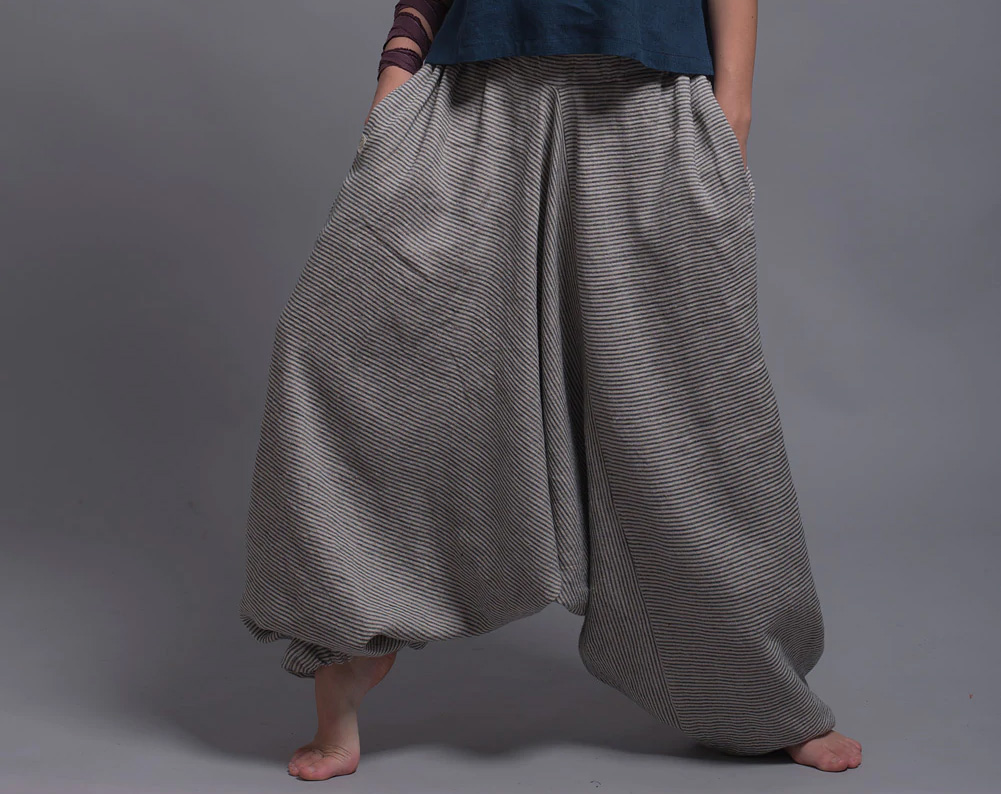Harem pants, alternatively known as genie pants or harem trousers, embody a distinct and relaxed style. Their hallmark lies in their unconventional, dropped crotch, which hangs considerably lower compared to conventional trousers. These pants feature voluminous, wide legs that gracefully taper down toward the ankles, lending them an air of nonchalant elegance. Typically boasting an elasticized waistband, harem pants are known for their comfort and ease of wear.
The moniker “harem pants” traces its roots to their historical association with the attire donned by women within the confines of harems or the inner palaces during the heyday of the Ottoman Empire in the Middle East. The ingenious design of harem pants allowed for unrestricted movement and comfort, rendering them ideal for leisurely pursuits and various activities within the harem. Gradually, this distinctive style made its way into Western fashion, finding favor among people from diverse corners of the globe.
Harem pants popularity
As a fashion phenomenon, harem pants surged in popularity within Western culture during the 20th century. Their ascent was facilitated by the endorsement of numerous fashion luminaries, artists, and musicians, particularly during the tumultuous 1960s and 1970s. Notable personalities and cultural movements that contributed to the rise of harem pants include:
- Designers: The French fashion designer Paul Poiret, who left an indelible mark on early 20th-century fashion, is often lauded for introducing harem pants to Western couture. His creations were heavily influenced by Middle Eastern aesthetics, incorporating elements like harem pants into his avant-garde designs.
- The Bohemian Culture and Hippie: The ’60s and ’70s witnessed harem pants becoming synonymous with counterculture and the free-spirited ethos of the hippie movement. The relaxed style found favor among those seeking a fashion statement that defied convention.
- Musical Icons and Celebrities: Musical legends like Jimi Hendrix and Mick Jagger, alongside other influential celebrities of that era, frequently donned harem pants both on stage and in their daily lives, further cementing the style’s popularity.
- A Glimpse of Global Culture: The burgeoning fascination with world cultures and travel during the ’60s and ’70s significantly bolstered the appeal of harem pants. People were drawn to the exotic allure and comfort of these trousers, reminiscent of attire from the Middle East and South Asia.
- Resurgence in Fashion Cycles: Harem pants have experienced periodic resurgences in fashion over the years, with designers and fashion houses consistently reincorporating them into their collections during various style renaissances.
What body type are harem pants suitable for?

When it comes to body shape, harem pants stand out for their relaxed and airy fit, which can complement a wide array of body types. They have earned their place in the fashion world due to the comfort they offer, making them a favored option for both casual and unconventional styles. However, those with shorter legs may find that harem pants with an exceptionally dropped crotch can sometimes create the illusion of even shorter legs. To achieve a more balanced look, opting for a style with a more moderate drop crotch or pairing them with heels can be a smart choice.
Harem pants defy gender boundaries and can be effortlessly embraced by both men and women. They have emerged as a unisex clothing trend, cherished for their comfort and unique aesthetic. When skillfully combined with other wardrobe pieces, harem pants can be a chic choice for a broad spectrum of occasions, ranging from leisurely outings to lively music festivals and even yoga or dance classes.
Other names for harem pants
Regarding their nomenclature, harem pants go by various names depending on the region and style: “genie pants”, “elephant pants”, “Aladdin pants”, “parachute pants”, “Sarouel pants”, “Thai pants”, “pantaloons”, and “bloomers”. Some popular alternative monikers for harem pants include:
- Genie Pants: This name conjures images of a genie’s attire, often featuring loose-fitting trousers with a dropped crotch, similar to harem pants.
- Hammer Pants: The term gained prominence thanks to MC Hammer, the American rapper and dancer known for his exaggerated harem-style pants, prominently featured in his music videos and performances during the late 1980s and early 1990s.
- Aladdin Pants: This name pays homage to the beloved character Aladdin from the famous folk tale “Aladdin and the Magic Lamp” and its Disney movie adaptation, who is frequently depicted wearing pants of a similar style.
- Sarouel Pants: In some regions, particularly in French-speaking countries, harem pants are referred to as “sarouel” pants, reflecting their Middle Eastern and North African roots.
The specific name used to describe these pants can vary based on cultural and contextual factors, but “harem pants” and “genie pants” remain widely recognized terms in English-speaking countries.
In summary, harem pants are loose-fitting trousers well-known for their distinctive dropped crotch and generously wide legs. They bear the name “harem pants” due to their historical connection with women’s clothing in Middle Eastern harems. These pants are versatile and inclusive, catering to individuals of diverse body shapes and genders, and their comfort and adaptability continue to make them a popular choice in contemporary fashion.
You can always order linen harem pants on our website with delivery worldwide.
